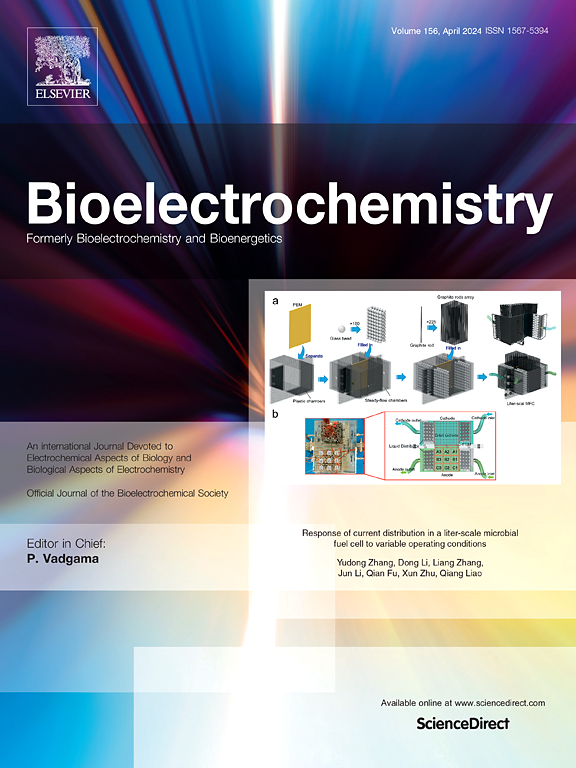Revealing the analytical potential of thin organic film electrodes: Electrochemical insights into anticancer drug docetaxel at liquid|liquid interfaces
IF 4.5
2区 化学
Q1 BIOCHEMISTRY & MOLECULAR BIOLOGY
引用次数: 0
Abstract
A thin organic film electrode (TOFE) system was employed for the indirect electrochemical investigation of docetaxel (DTX), an anticancer drug from the class of mitotic inhibitors. The TOFE consists of a thin membrane immobilized on a carbon electrode substrate, composed of a water-immiscible organic solvent that forms a stable liquid│liquid interface upon immersion in an aqueous electrolyte. Due to the high oxidation potential of DTX at solid electrodes, an alternative detection strategy was adopted based on the interaction between DTX and the liquid|liquid interface of the TOFE. Systematic optimization of the organic and aqueous phase compositions, as well as the electrode material, was first performed in the absence of DTX to ensure reliable and reproducible conditions at the interface. The optimized TOFE system, based on nitrobenzene as the organic solvent, perchlorate anions as the supporting electrolyte, and an edge-plane pyrolytic graphite as electrode material, provided the best performance. The optimal electrochemical response was also observed when perchlorate anions were present in the aqueous phase, while the nature of the cations in the aqueous phase had negligible influence. The optimized TOFE system was then used to study the effect of DTX on ion transfer processes at the liquid│liquid interface, where a pronounced, concentration-dependent inhibitory effect was observed. Electrochemical investigations using cyclic voltammetry and square-wave voltammetry (SWV), including frequency- and amplitude-dependent analyses, demonstrated that DTX adsorbs to the membrane│water interface, forming blocking layer that markedly slowing ion transfer and displacing the quasi-reversible maxima beyond the instrumentally accessible window. The system exhibited a linear analytical response in the concentration range of 10.0–100.0 μmol L−1 DTX, with low detection and quantification limits when analyzed by SWV. The LOD values were 3.27 μmol L−1 (anodic) and 3.26 μmol L−1 (cathodic), while the LOQ were 9.90 μmol L−1 and 9.89 μmol L−1, respectively. These findings validate the TOFE platform as a robust and versatile tool for the indirect detection of redox-inactive pharmaceutical compounds in biphasic electrochemical systems. Given the key role of mitotic inhibitors like DTX in cancer therapy, studying their behavior at biomimetic interfaces may advance understanding of drug–membrane interactions and support the development of improved delivery and diagnostic strategies.

揭示有机薄膜电极的分析潜力:在液体|液体界面上对抗癌药物多西他赛的电化学见解
采用有机薄膜电极(TOFE)系统对有丝分裂抑制剂类抗癌药物多西紫杉醇(DTX)进行了间接电化学研究。TOFE由固定在碳电极衬底上的薄膜组成,由水不混溶的有机溶剂组成,在水电解质中浸泡后形成稳定的液体│液体界面。由于DTX在固体电极处的高氧化电位,采用了一种基于DTX与TOFE的液体|液体界面相互作用的替代检测策略。在没有DTX的情况下,首先对有机相和水相组成以及电极材料进行了系统优化,以确保界面条件的可靠性和可重复性。以硝基苯为有机溶剂,高氯酸盐阴离子为支撑电解质,边缘平面热解石墨为电极材料的TOFE体系性能最佳。当水相中存在高氯酸盐阴离子时,电化学响应最佳,而水相中阳离子的性质对电化学响应的影响可以忽略不计。然后,利用优化后的TOFE体系研究了DTX对液-│液界面离子转移过程的影响,在此过程中观察到明显的浓度依赖性抑制效应。使用循环伏安法和方波伏安法(SWV)进行的电化学研究,包括频率和振幅相关分析,表明DTX吸附在膜│水界面上,形成阻塞层,显著减缓离子转移,并在仪器可达的窗口之外取代准可逆最大值。该体系在10.0 ~ 100.0 μmol L−1 DTX浓度范围内具有良好的线性响应,SWV检测限和定量限较低。LOD分别为3.27 μmol L−1(阳极)和3.26 μmol L−1(阴极),LOQ分别为9.90 μmol L−1和9.89 μmol L−1。这些发现验证了TOFE平台是双相电化学系统中间接检测氧化还原活性药物化合物的强大而通用的工具。鉴于DTX等有丝分裂抑制剂在癌症治疗中的关键作用,研究它们在仿生界面上的行为可能会促进对药物-膜相互作用的理解,并支持改进给药和诊断策略的发展。
本文章由计算机程序翻译,如有差异,请以英文原文为准。
求助全文
约1分钟内获得全文
求助全文
来源期刊

Bioelectrochemistry
生物-电化学
CiteScore
9.10
自引率
6.00%
发文量
238
审稿时长
38 days
期刊介绍:
An International Journal Devoted to Electrochemical Aspects of Biology and Biological Aspects of Electrochemistry
Bioelectrochemistry is an international journal devoted to electrochemical principles in biology and biological aspects of electrochemistry. It publishes experimental and theoretical papers dealing with the electrochemical aspects of:
• Electrified interfaces (electric double layers, adsorption, electron transfer, protein electrochemistry, basic principles of biosensors, biosensor interfaces and bio-nanosensor design and construction.
• Electric and magnetic field effects (field-dependent processes, field interactions with molecules, intramolecular field effects, sensory systems for electric and magnetic fields, molecular and cellular mechanisms)
• Bioenergetics and signal transduction (energy conversion, photosynthetic and visual membranes)
• Biomembranes and model membranes (thermodynamics and mechanics, membrane transport, electroporation, fusion and insertion)
• Electrochemical applications in medicine and biotechnology (drug delivery and gene transfer to cells and tissues, iontophoresis, skin electroporation, injury and repair).
• Organization and use of arrays in-vitro and in-vivo, including as part of feedback control.
• Electrochemical interrogation of biofilms as generated by microorganisms and tissue reaction associated with medical implants.
 求助内容:
求助内容: 应助结果提醒方式:
应助结果提醒方式:


